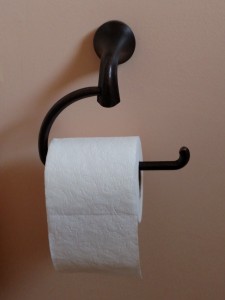Rotten News: A Salmonella Story

Non-typhoidal Salmonella usually causes fever and crampy diarrhea. This stomach bug mainly lurks in raw poultry, raw eggs, raw beef, and unpasturized dairy products. Luckily, salmonella does not jump up and attack humans. People are safe from disease as long as they do not eat salmonella-infested food.
In the case of my pot of rotten chicken, the obvious stench warned me that it was inedible. However, salmonella often hides in food and it is difficult to tell what is or is not contaminated. A perfectly fine looking egg may harbor the germ. Even before this outbreak, the Centers for Disease Control estimates in the United States as many as 1 in 50 people are exposed to a contaminated egg each year.
Luckily salmonella is killed by heat and bleach. Even if an egg has salmonella, adequate cooking will destroy the bacteria. Gone are the days when parents can feed kids soft boiled eggs in a silver cup, have kids wipe up with toast the yolk from a sunny-side up egg, or add a raw egg to a milkshake. Instead, cook your hardboiled eggs until the yolks are green and crumble, and tolerate a little crispness to your scrambled eggs. Wash all utensils well. The disinfecting solution used in childcare centers of ¼ cup bleach to 1 gallon water works well to sanitize counters. Do not keep perishable food, even if it is cooked, out at room temperature for more than two hours.
A mom once called me frantic because her child had just happily eaten a half-cooked chicken nugget. What if this happens to your child? Don’t panic. Watch for symptoms — the onset of diarrhea from salmonella is usually between 12 to 36 hours after exposure but can occur up to three days later. The diarrhea can last up to 5-7 days. If symptoms occur, the general recommendation is to ride it out. Prevent dehydration by giving plenty of fluids. My simple rule to prevent dehydration is that more must go in than comes out.
According to the American Academy of Pediatric’s 2009 infectious diseases report, antibiotic treatment may be considered for unusually severe symptoms or if your child is at risk for overwhelming infection. People at high risk for overwhelming disease include infants younger than three months old and those with abnormal immune systems (cancer, HIV, Sickle Cell disease, kids taking daily steroids for other illnesses). Using antibiotics in a typical case of salmonella not only promotes general antibiotic resistance, but in fact does not shorten the time frame for the illness. Also, the medication can prolong how long your child carries the germ in his stool.
I ended up tying the chicken up, pot and all, in a plastic grocery bag and throwing out the whole mess. Don’t tell my husband, he is the kind of guy who gets annoyed because I throw out germy sponges on a frequent basis. If he knew, he’d probably want me to at least keep the pot. Yuck.
Naline Lai, MD with Julie Kardos, MD
©2010 Two Peds in a Pod℠
 Need ideas on what to pack in your child’s lunch bag? Beware of junk food masquerading as healthy food. Dr. Roxanne Sukol, an internist who writes the popular nutrition blog
Need ideas on what to pack in your child’s lunch bag? Beware of junk food masquerading as healthy food. Dr. Roxanne Sukol, an internist who writes the popular nutrition blog  Debunking myths about soy, our guest blogger today is esteemed pediatrician Dr. Roy Benaroch.
Debunking myths about soy, our guest blogger today is esteemed pediatrician Dr. Roy Benaroch. We welcome guest blogger Dr. Alissa Packer who informs us about Cryptosporidium.
We welcome guest blogger Dr. Alissa Packer who informs us about Cryptosporidium.  Earlier in the month I attended a developmental pediatrics conference in Philadelphia. The keynote speaker, Barry Zuckerman MD, professor and chairman of pediatrics at Boston University, raised a set of thoughtful questions. Parents can use the answers as a starting point for understanding how they were raised. Here are some of the questions with modifications:
Earlier in the month I attended a developmental pediatrics conference in Philadelphia. The keynote speaker, Barry Zuckerman MD, professor and chairman of pediatrics at Boston University, raised a set of thoughtful questions. Parents can use the answers as a starting point for understanding how they were raised. Here are some of the questions with modifications:
 Unfortunately, constipation and
Unfortunately, constipation and  Our guest blogger today is Dr. Jason Komasz. Practicing pediatrics in Pennsylvania for nearly a decade, he is the father of two and a respected colleague.
Our guest blogger today is Dr. Jason Komasz. Practicing pediatrics in Pennsylvania for nearly a decade, he is the father of two and a respected colleague. In honor of Father’s Day, we bring you our second “Top Ten” list.
In honor of Father’s Day, we bring you our second “Top Ten” list. “I need a nap!”—recognize this tired parent?
“I need a nap!”—recognize this tired parent? Ten years ago I watched a very sick, feverish toddler arch his back on my exam table while a high pitched screech weakly escaped his mouth as I tried to examine him. Attempts by his mother to cradle him in her arms only resulted in more pain.
Ten years ago I watched a very sick, feverish toddler arch his back on my exam table while a high pitched screech weakly escaped his mouth as I tried to examine him. Attempts by his mother to cradle him in her arms only resulted in more pain.